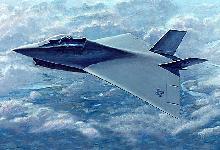P-47 vs. JSF.

This is coolbert:
It used to be that every self-respecting air force in the world had a large number of different types of aircraft in their inventory.
For every distinct function that could be thought of, there was a different, special version. Pursuit [later called interceptor], fighter [for dogfights], fighter-bomber, dive bomber [ground attack], heavy bomber, medium bomber, reconnaissance, utility, transport, day and night aircraft, the list seemed to be endless.
And in the years prior to, during, and after WW2, it also seemed that endless new versions were being developed and fielded. The technology of flight was developing so rapidly that just as soon as a new type aircraft rolled off the assembly line, it was already outmoded and a new type to replace it was already on the drawing boards.
This practice of having so many different specialized versions of aircraft has gone the way of the dodo, for the most part.
The current concept is to have one or at the most two types of combat aircraft that can perform a variety of functions, and perform them well.
One aircraft that can be fitted with a wide range of equipment to perform whatever function it is tasked with.
For the recon mission, the aircraft can be fitted with specialized cameras and stripped of excess weaponry.
For air-air combat, missiles and guns can be fitted to the aircraft.
An assortment of weaponry, missiles, rockets, cannon, bombs, etc, can be fitted to the aircraft to make it a bomber/fighter bomber/dive bomber, etc.
Shed the bombs and the aircraft is instantly a fighter for dogfighting.
Advanced avionics [aviation electronics] allow the aircraft to fly and fight in day or night, good conditions or inclement, etc.
Ordnance can be precision dropped using GPS and systems such as JDAM [joint direct attack munition].
From the start the aircraft can be designed to have a capability for STOL [short take offs and landings], and work from improvised air fields. An all around aircraft that can be configured for a variety of functions, and do them well.
Well, that is the problem!
Do a variety of functions and do them well.
It is hard to design such a beast that can do it all and has the capability to do them all well.
Cost and time are major factors here too.
A P-47 Thunderbolt cost to build about $40,000 per copy during WW2.
And the design team took three days working in a hotel room to work out all the equations for the initial design!!
This design, as I have said before, was probably close to being outmoded as it came off the assembly line for the first time.
I think that the cost of a P-47 in today's dollars would be from around $ 1 to 2 million per copy.
Today, the latest designs for the USAF plane of the future, seem to run about $38 million per copy [this figure may be too low, but then, what do I know]!!??
Of course, this latest plane for the USAF of the future, the Joint Strike Fighter [JSF] is touted as being able to do it all.
And do all well too.
And will be the mainstay of the USAF for years and decades into the future.
No more new designs every few years. Too expensive to do. You cannot build and replace aircraft on a frenetic basis any more.
Engineer military officers make a whole twenty year career of shepherding a newly designed plane from the design phase to the factory to the sky and then through a whole process of upgrades and such.
coolbert.

<< Home